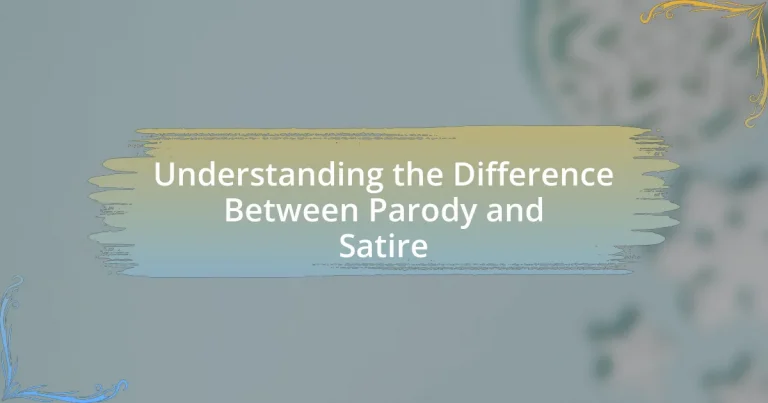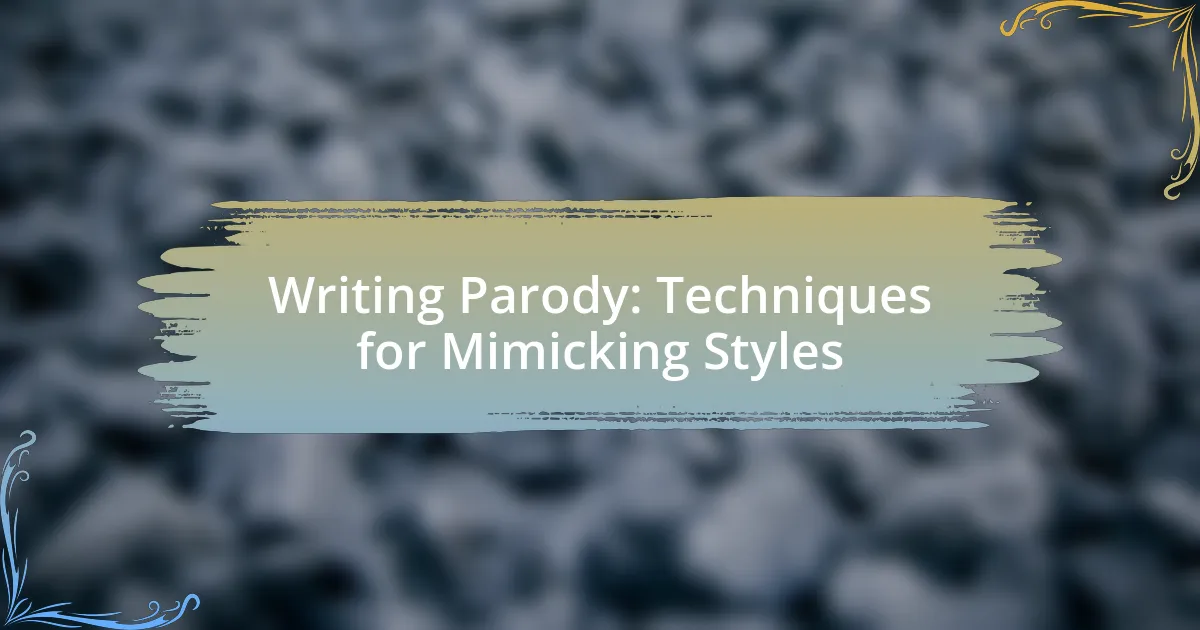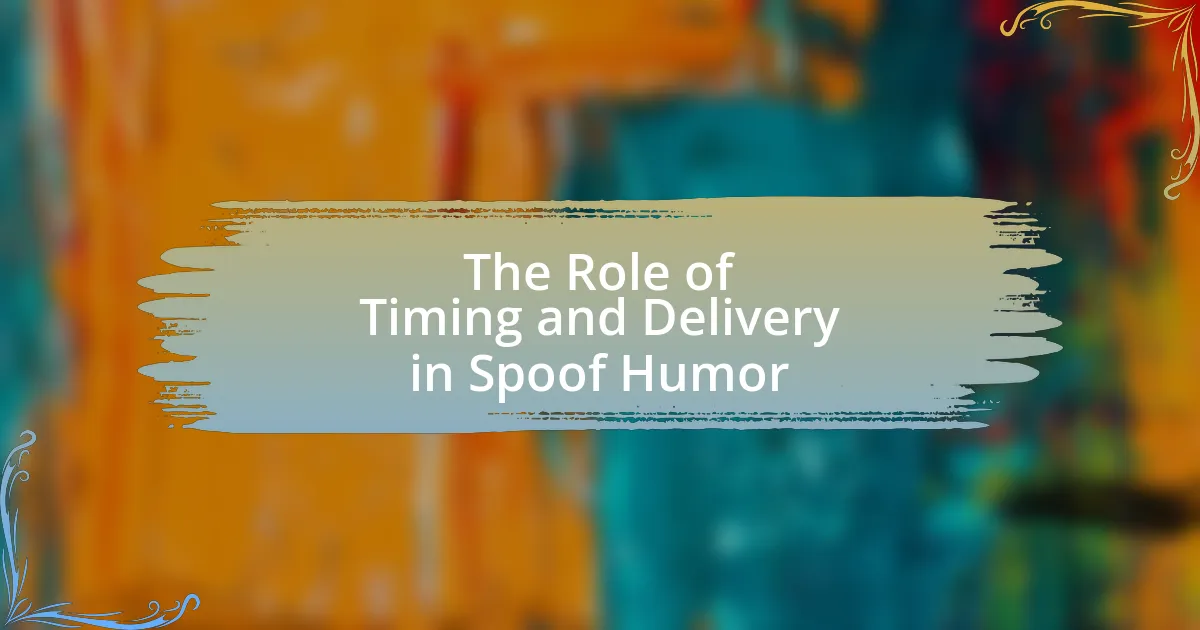Parody and satire are two distinct forms of humor that serve different purposes in literature and media. Parody imitates a specific work or style for comedic effect, often exaggerating its characteristics, while satire critiques societal norms and human behavior through irony and exaggeration. This article explores the definitions, characteristics, and historical examples of both forms, highlighting their intentions and impacts on modern media and public perception. Additionally, it addresses the challenges and ethical considerations associated with using parody and satire, providing best practices for creators to ensure their work is both humorous and respectful.
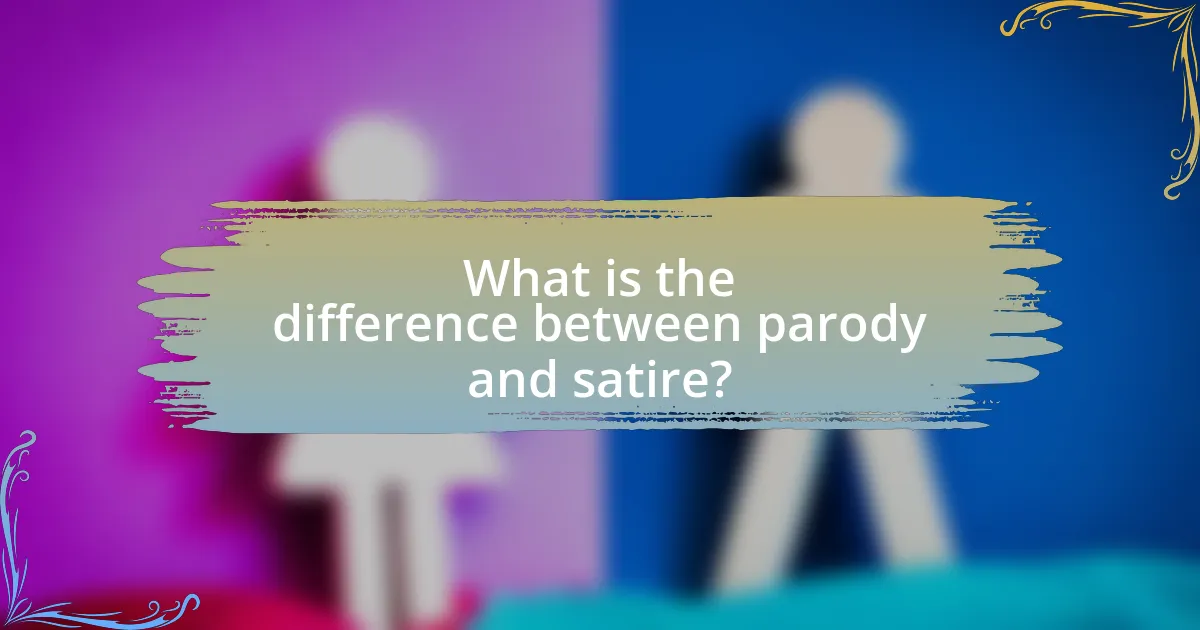
What is the difference between parody and satire?
Parody and satire are distinct forms of humor, with parody primarily imitating a specific work or style for comedic effect, while satire critiques societal norms or human behavior through exaggeration and irony. Parody focuses on mimicking the original source, often highlighting its flaws or absurdities, as seen in works like “Weird Al” Yankovic’s song parodies. In contrast, satire aims to provoke thought and inspire change by addressing broader issues, exemplified by Jonathan Swift’s “A Modest Proposal,” which critiques social injustices. Thus, the key difference lies in parody’s focus on imitation for humor versus satire’s intent to critique and provoke reflection.
How do parody and satire define themselves in literature and media?
Parody and satire are distinct forms of expression in literature and media that serve to critique or comment on their subjects. Parody imitates the style of a particular work or genre to create a humorous effect, often exaggerating its characteristics for comedic purposes. For example, “The Hunger Pains” parodies the “Hunger Games” series by mimicking its narrative style while introducing absurd elements. In contrast, satire employs humor, irony, or exaggeration to criticize societal norms, politics, or human behavior, aiming to provoke thought or change. A notable example is Jonathan Swift’s “A Modest Proposal,” which satirizes British policy towards the Irish by suggesting an outrageous solution to poverty. Both forms utilize humor but differ in intent and execution, with parody focusing on imitation and satire on social critique.
What are the key characteristics that distinguish parody from satire?
Parody and satire are distinct forms of humor, primarily differentiated by their intent and execution. Parody imitates the style of a particular work or genre to create a humorous effect, often exaggerating its characteristics for comedic purposes, while satire aims to critique or mock societal issues, behaviors, or institutions through humor, irony, or exaggeration. For example, a parody of a popular song may mimic its melody and lyrics to create a funny version, whereas a satirical piece might use humor to highlight the absurdity of political corruption. This distinction is crucial in understanding how each form engages with its subject matter, with parody focusing on imitation and satire on social commentary.
How do the intentions behind parody and satire differ?
Parody and satire differ in their intentions, with parody primarily aiming to imitate and entertain, while satire seeks to critique and provoke thought. Parody often exaggerates the style or content of the original work for comedic effect, as seen in works like “Weird Al” Yankovic’s song parodies, which mimic popular songs to create humor. In contrast, satire uses humor, irony, or exaggeration to criticize societal issues or human behavior, exemplified by Jonathan Swift’s “A Modest Proposal,” which addresses social injustices through shocking irony. Thus, while both forms utilize humor, their core intentions diverge significantly: parody focuses on imitation for amusement, whereas satire aims for social commentary and critique.
What are some historical examples of parody and satire?
Historical examples of parody and satire include Jonathan Swift’s “A Modest Proposal,” which satirizes British policy towards the Irish by suggesting the consumption of Irish infants as a solution to poverty. Another example is “Don Quixote” by Miguel de Cervantes, which parodies the chivalric romances of its time, critiquing the absurdity of idealism. Additionally, the works of the Roman poet Juvenal, particularly his “Satires,” provide early examples of social and political critique through satire. These examples illustrate how parody and satire have been used throughout history to comment on societal issues and provoke thought.
How has parody evolved over time in various cultures?
Parody has evolved significantly over time across various cultures, adapting to social, political, and artistic contexts. In ancient Greece, playwrights like Aristophanes used parody to critique societal norms and political figures, blending humor with commentary. During the Renaissance, parody emerged in literature and art, with figures like Cervantes employing it to mock chivalric ideals in “Don Quixote.” The 18th century saw the rise of parody in English literature, exemplified by works from authors like Alexander Pope, who used it to satirize contemporary society and literary styles. In the 20th century, parody expanded into film and television, with programs like “Saturday Night Live” and “The Simpsons” using it to comment on current events and pop culture. This evolution reflects the adaptability of parody as a tool for critique and entertainment, demonstrating its relevance across different eras and cultures.
What notable works exemplify satire throughout history?
Notable works that exemplify satire throughout history include “Gulliver’s Travels” by Jonathan Swift, “A Modest Proposal” also by Swift, “The Adventures of Huckleberry Finn” by Mark Twain, and “Animal Farm” by George Orwell. “Gulliver’s Travels,” published in 1726, critiques human nature and society through fantastical voyages. “A Modest Proposal,” published in 1729, uses irony to address the dire economic conditions in Ireland. “The Adventures of Huckleberry Finn,” published in 1884, satirizes societal norms and racism in America. “Animal Farm,” published in 1945, allegorizes the Russian Revolution and critiques totalitarianism. Each of these works employs humor and irony to provoke thought and critique societal issues, establishing their significance in the literary canon of satire.
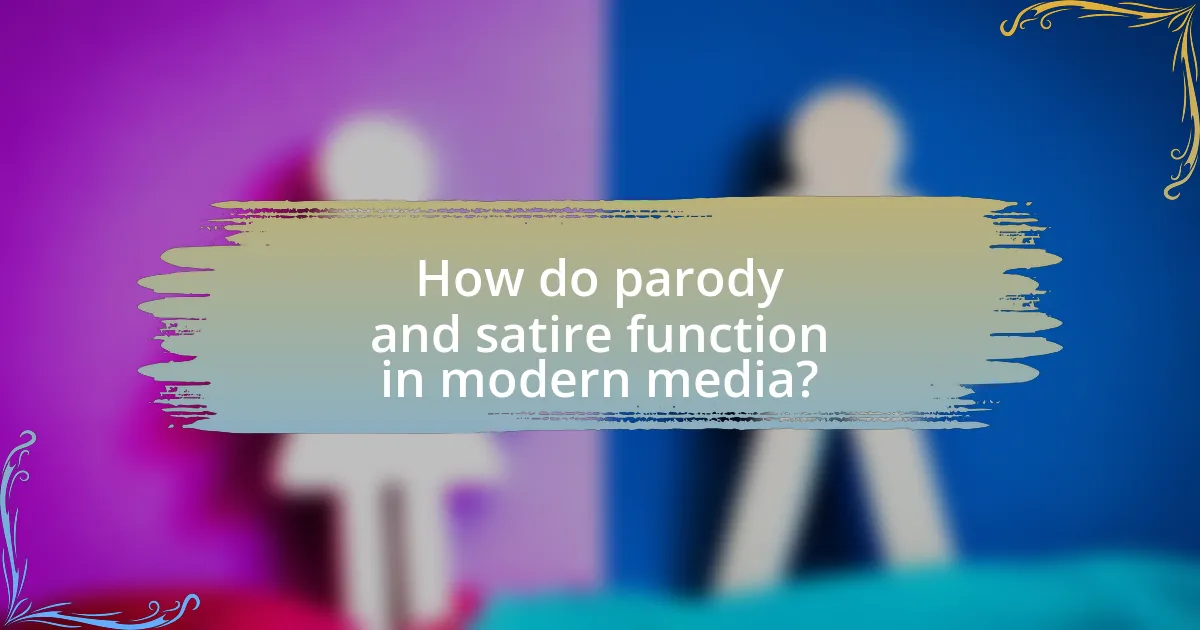
How do parody and satire function in modern media?
Parody and satire function in modern media as tools for critique and entertainment, often targeting societal norms, political issues, and cultural phenomena. Parody imitates the style of a particular genre or work to create humor, while satire employs irony and exaggeration to expose flaws or absurdities in its subjects. For instance, television shows like “Saturday Night Live” use satire to comment on current events and political figures, effectively engaging audiences while provoking thought. Research indicates that satire can enhance public discourse by encouraging critical thinking and fostering awareness of social issues, as seen in studies published in the Journal of Communication.
What role do parody and satire play in contemporary entertainment?
Parody and satire serve as critical tools in contemporary entertainment by providing social commentary and provoking thought. Parody mimics and exaggerates the style of a particular genre or work, often to entertain while highlighting its absurdities, as seen in shows like “Weird Al” Yankovic’s music parodies. Satire, on the other hand, critiques societal norms, politics, and cultural phenomena, exemplified by programs like “Saturday Night Live,” which uses humor to address serious issues. Both forms encourage audiences to reflect on their beliefs and the world around them, fostering a deeper understanding of complex topics through humor and exaggeration.
How do audiences respond differently to parody versus satire?
Audiences respond differently to parody and satire primarily based on their intent and emotional engagement. Parody often elicits amusement through imitation and exaggeration of a specific work or genre, allowing audiences to enjoy the humor without necessarily critiquing the original. For example, “Weird Al” Yankovic’s song parodies are celebrated for their comedic value while remaining light-hearted. In contrast, satire aims to provoke thought and critique societal issues, often leading audiences to reflect on the underlying message. A notable example is “The Daily Show,” which uses satire to address political issues, prompting viewers to consider their implications. This distinction in audience response is rooted in the differing objectives of parody and satire: one seeks entertainment through mimicry, while the other encourages critical reflection on real-world issues.
What are the implications of using parody and satire in social commentary?
The implications of using parody and satire in social commentary include the ability to critique societal norms and provoke thought while entertaining audiences. Parody mimics and exaggerates specific elements of culture, allowing for a humorous critique that can make serious issues more accessible. Satire, on the other hand, employs irony and exaggeration to highlight flaws in individuals or systems, often aiming to inspire change or reflection. Historical examples, such as Jonathan Swift’s “A Modest Proposal,” demonstrate how satire can effectively address social injustices by shocking audiences into awareness. Both forms can foster dialogue and encourage critical thinking, making them powerful tools in social discourse.
How do parody and satire influence public perception?
Parody and satire significantly influence public perception by providing critical commentary on societal norms, politics, and culture. These forms of humor often exaggerate or distort reality, prompting audiences to question established beliefs and behaviors. For instance, shows like “Saturday Night Live” and “The Daily Show” use satire to highlight political absurdities, shaping viewers’ opinions and increasing political engagement. Research indicates that exposure to satirical content can enhance political knowledge and motivate civic participation, as evidenced by a study published in the journal “Political Communication,” which found that satirical news can lead to greater awareness of political issues among young adults. Thus, parody and satire serve as powerful tools for reflection and discourse, ultimately shaping public attitudes and perceptions.
What impact do parody and satire have on political discourse?
Parody and satire significantly influence political discourse by shaping public perception and encouraging critical thinking. These forms of expression often highlight the absurdities and contradictions within political narratives, making complex issues more accessible and engaging for the audience. For instance, shows like “Saturday Night Live” and “The Daily Show” have historically impacted political opinions and voter behavior by using humor to critique political figures and policies, as evidenced by studies showing that exposure to satirical content can increase political awareness and engagement among viewers.
How can parody and satire shape cultural narratives?
Parody and satire shape cultural narratives by critiquing societal norms and values through humor and exaggeration. These forms of expression allow creators to highlight absurdities and contradictions within cultural practices, prompting audiences to reflect on and question the status quo. For instance, television shows like “Saturday Night Live” use satire to comment on political events, influencing public perception and discourse. Research indicates that satire can enhance political engagement, as demonstrated in a study by the Pew Research Center, which found that individuals exposed to satirical content were more likely to discuss political issues. Thus, parody and satire serve as powerful tools for cultural commentary and transformation.
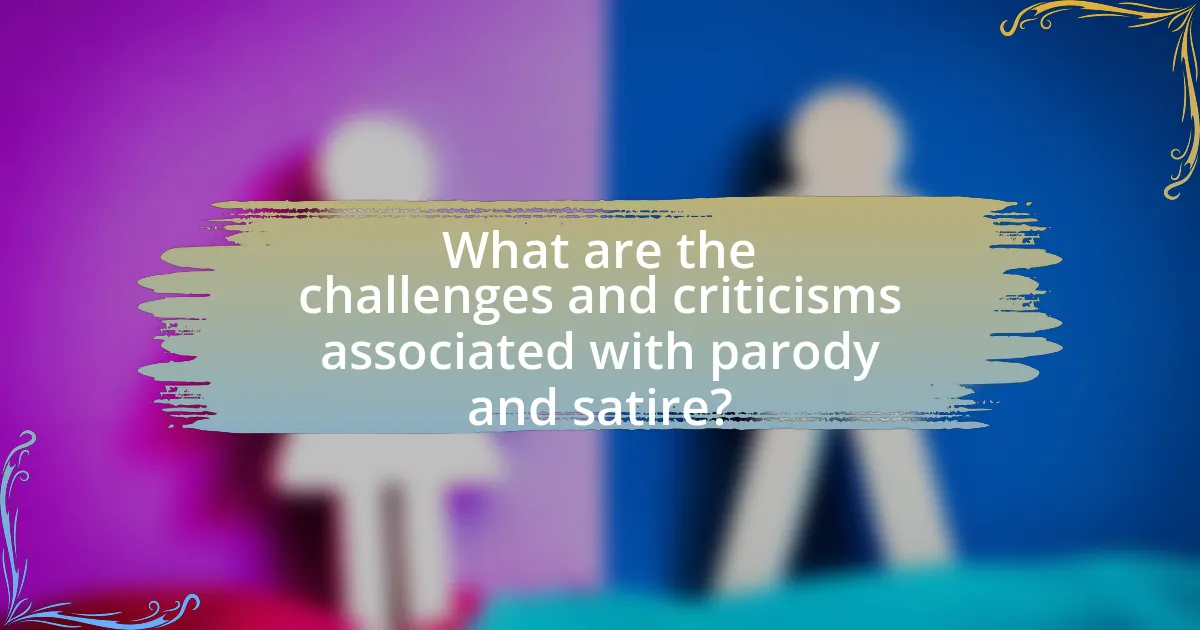
What are the challenges and criticisms associated with parody and satire?
Parody and satire face challenges and criticisms primarily related to issues of misinterpretation and potential harm. Misinterpretation occurs when audiences fail to recognize the intended humor or critique, leading to confusion or offense. For instance, a satirical piece aimed at highlighting societal flaws may be taken literally, resulting in backlash against the creator. Additionally, both forms can perpetuate stereotypes or reinforce negative perceptions, particularly when targeting marginalized groups. Critics argue that this can contribute to social division rather than promote understanding. Furthermore, legal challenges, such as copyright infringement claims, can arise when parody blurs the line with original works, complicating the legal landscape for creators. These challenges highlight the delicate balance required in crafting effective parody and satire.
What ethical considerations arise in the use of parody and satire?
The ethical considerations in the use of parody and satire primarily involve issues of copyright, defamation, and the potential for harm. Parody, while protected under fair use in many jurisdictions, can still infringe on the original creator’s rights if it does not sufficiently transform the original work. Defamation arises when satire targets individuals or groups, potentially leading to reputational damage. Additionally, both forms can perpetuate stereotypes or misinformation, raising concerns about social responsibility. For instance, the U.S. Supreme Court case Campbell v. Acuff-Rose Music, Inc. established that parody can be fair use, but it must be evaluated on a case-by-case basis, highlighting the nuanced ethical landscape surrounding these forms of expression.
How can parody and satire be misinterpreted or misused?
Parody and satire can be misinterpreted or misused when audiences fail to recognize the intent behind the humor, leading to confusion about the original message. For instance, parody often exaggerates characteristics of the subject to create humor, but if viewers take the parody at face value, they may misinterpret it as a genuine representation rather than a comedic critique. Similarly, satire aims to provoke thought about societal issues, but if the audience does not grasp the underlying critique, they may perceive it as offensive or inappropriate. Historical examples include the backlash against satirical cartoons that were intended to critique political figures but were instead taken literally, resulting in public outrage. This misinterpretation can undermine the effectiveness of both parody and satire, transforming them from tools of social commentary into sources of misunderstanding.
What are the potential consequences of crossing the line in parody and satire?
Crossing the line in parody and satire can lead to legal repercussions, social backlash, and damage to reputations. Legally, creators may face lawsuits for defamation or copyright infringement if their work is deemed harmful or excessively derivative. Socially, audiences may react negatively, perceiving the content as offensive or inappropriate, which can result in public outrage or boycotts. Additionally, reputational harm can occur for both the creator and the subjects of the parody or satire, potentially leading to loss of professional opportunities or credibility. Historical examples include the backlash against certain satirical cartoons that sparked protests, illustrating the tangible consequences of crossing boundaries in humor.
What best practices should creators follow when using parody and satire?
Creators should ensure that their parody and satire are clearly distinguishable from the original work to avoid copyright infringement. This can be achieved by transforming the original content significantly, adding commentary or critique that highlights the differences. Additionally, creators should consider the context and intent behind their work, ensuring that it serves a purpose such as social commentary or humor rather than simply replicating the original. Legal precedents, such as the “fair use” doctrine in the United States, support the use of parody and satire when they provide commentary or criticism, as established in cases like Campbell v. Acuff-Rose Music, Inc. (1994), which affirmed that transformative use is a key factor in fair use determinations.
How can creators ensure their work is respectful while still being humorous?
Creators can ensure their work is respectful while still being humorous by focusing on the intent and context of their humor. By prioritizing empathy and understanding the perspectives of their audience, creators can craft jokes that are inclusive rather than derogatory. For instance, humor that highlights shared experiences or common human flaws tends to resonate positively, as it fosters connection rather than division. Additionally, creators can avoid stereotypes and offensive tropes, which often alienate or harm specific groups. Research indicates that humor that promotes social cohesion and understanding is more effective and well-received, as seen in studies on comedy’s role in social dynamics.
What strategies can be employed to effectively convey messages through parody and satire?
To effectively convey messages through parody and satire, creators should employ exaggeration, irony, and cultural references. Exaggeration amplifies traits or behaviors to highlight absurdities, making the message more impactful; for example, political cartoons often exaggerate politicians’ features or actions to critique their policies. Irony contrasts reality with expectations, allowing audiences to recognize the discrepancies in societal norms or behaviors, as seen in satirical television shows like “Saturday Night Live,” which often use irony to comment on current events. Cultural references ground the parody or satire in familiar contexts, making the message relatable and easier to understand; for instance, referencing popular films or music can enhance the comedic effect while delivering a critique. These strategies, when combined, create a powerful medium for social commentary and provoke thought among audiences.
